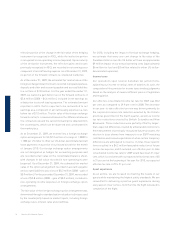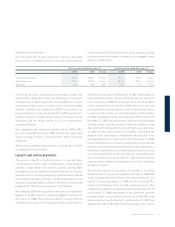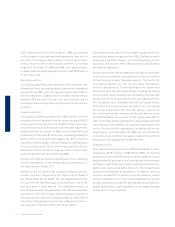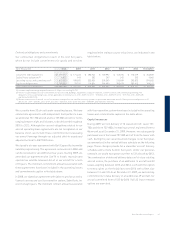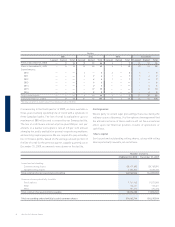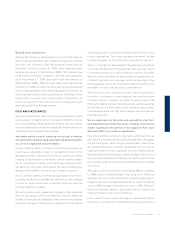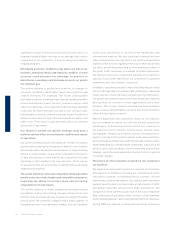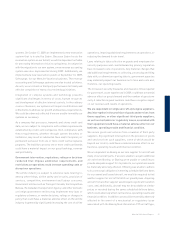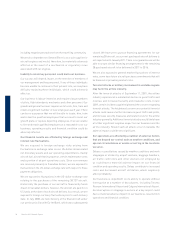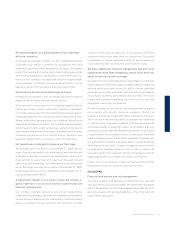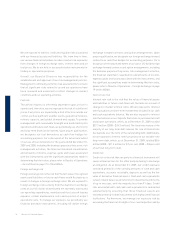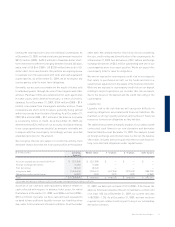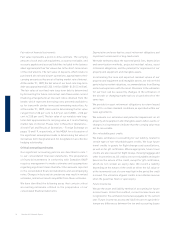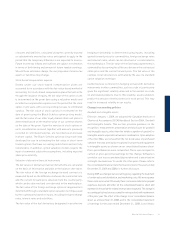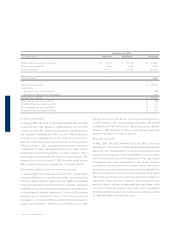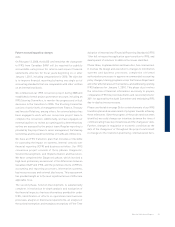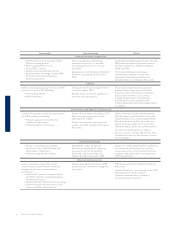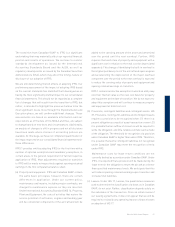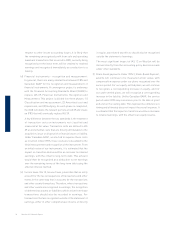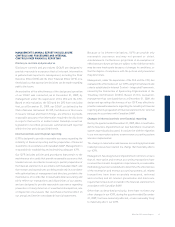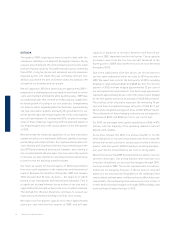Westjet 2009 Annual Report Download - page 60
Download and view the complete annual report
Please find page 60 of the 2009 Westjet annual report below. You can navigate through the pages in the report by either clicking on the pages listed below, or by using the keyword search tool below to find specific information within the annual report.
30 WestJet 2009 Annual Report
exchange forward contracts and option arrangements. Upon
proper qualifi cation, we designate our foreign exchange forward
contracts as cash fl ow hedges for accounting purposes. For a
discussion of the nature and extent of our use of US-dollar foreign
exchange forward contracts and option arrangements, including
the business purposes they serve; risk management activities;
the fi nancial statement classifi cation and amounts of income,
expense, gains and losses associated with the instruments; and
the signifi cant assumptions made in determining their fair value,
please refer to Results of Operations – Foreign Exchange on page
19 of this MD&A.
Interest rate risk
Interest rate risk is the risk that the value of fi nancial assets
and liabilities or future cash fl ows will fl uctuate as a result of
changes in market interest rates. We are exposed to interest
rate fl uctuations on short-term investments included in our cash
and cash equivalents balance. We are also exposed to interest
rate fl uctuations on our deposits that relate to purchased aircraft
and airport operations, which, as at December 31, 2009, totalled
$27.3 million (2008 – $24.3 million). The fi xed-rate nature of the
majority of our long-term debt reduces the risk of interest rate
fl uctuations over the term of the outstanding debt. Additionally,
we are exposed to interest rate fl uctuations on our variable-rate
long-term debt, which, as at December 31, 2009, totalled $8.6
million (2008 – $11.2 million) or 0.7 per cent (2008 – 0.8 per cent)
of our total long-term debt.
Credit risk
Credit risk is the risk that one party to a fi nancial instrument will
cause a fi nancial loss for the other party by failing to discharge
an obligation. As at December 31, 2009, our credit exposure
consisted primarily of the carrying amounts of cash and cash
equivalents, accounts receivable, deposits, as well as the fair
value of derivative fi nancial assets. Cash and cash equivalents
consist of bank balances and short-term investments with terms
of up to one year, with the majority less than 91 days. Credit
risk associated with cash and cash equivalents is minimized
substantially by ensuring that these financial assets are
invested primarily in debt instruments with highly rated fi nancial
institutions. Furthermore, we manage our exposure risk by
assessing the fi nancial strength of our counterparties and by
We are exposed to market, credit and liquidity risks associated
with our fi nancial assets and liabilities. We, from time to time,
use various fi nancial derivatives to reduce market risk exposures
from changes in foreign exchange rates, interest rates and jet
fuel prices. We do not hold or use any derivative instruments for
trading or speculative purposes.
Overall, our Board of Directors has responsibility for the
establishment and approval of our risk management policies.
Management continually performs risk assessments to ensure
that all signifi cant risks related to us and our operations have
been reviewed and assessed to reflect changes in market
conditions and our operating activities.
Fuel risk
The airline industry is inherently dependent upon jet fuel to
operate and, therefore, we are exposed to the risk of volatile fuel
prices. Fuel prices are impacted by a host of factors outside our
control, such as signifi cant weather events, geopolitical tensions,
refi nery capacity, and global demand and supply. To provide
management with reasonable foresight and predictability into
operations and future cash fl ows, we periodically use short-term
and long-term fi nancial derivatives. Upon proper qualifi cation,
we designate our fuel derivatives as cash flow hedges for
accounting purposes. For a discussion of the nature and extent
of our use of fuel derivatives for the years ended December 31,
2009 and 2008, including the business purposes they serve; risk
management activities; the fi nancial statement classifi cation
and amounts of income, expense, gains and losses associated
with the instruments; and the signifi cant assumptions made in
determining their fair value, please refer to Results of Operations
– Aircraft Fuel on page 15 of this MD&A.
Foreign exchange risk
Foreign exchange risk is the risk that the fair value of recognized
assets and liabilities or future cash fl ows would fl uctuate as a
result of changes in foreign exchange rates. We are exposed to
foreign exchange risks arising from fl uctuations in exchange
rates on our US-dollar-denominated net monetary assets and
our operating expenditures, mainly aircraft fuel, aircraft leasing
expense, certain maintenance costs and a portion of airport
operations costs. To manage our exposure, we periodically use
fi nancial derivative instruments, including US-dollar foreign


